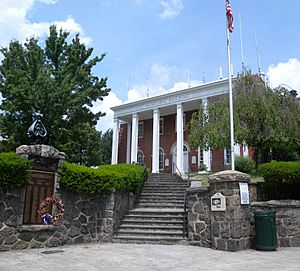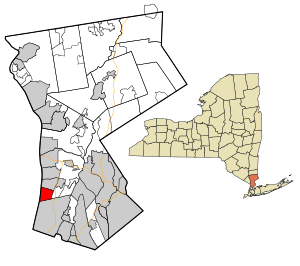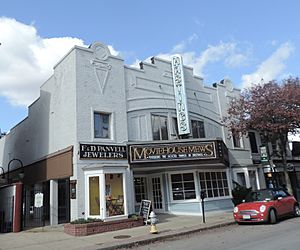Hastings-on-Hudson, New York facts for kids
Quick facts for kids
Hastings-on-Hudson, New York
|
|
|---|---|

Municipal building
|
|

Location of Hastings-on-Hudson, New York
|
|
| Country | United States |
| State | New York |
| County | Westchester |
| Town | Greenburgh |
| Area | |
| • Total | 2.94 sq mi (7.62 km2) |
| • Land | 1.98 sq mi (5.13 km2) |
| • Water | 0.96 sq mi (2.49 km2) |
| Population
(2020)
|
|
| • Total | 8,590 |
| • Density | 4,338.38/sq mi (1,674.46/km2) |
| Time zone | UTC-5 (Eastern (EST)) |
| • Summer (DST) | UTC-4 (EDT) |
| ZIP codes |
10706
|
| Area code(s) | 914 |
| FIPS code | 36-32710 |
| Website | http://hastingsgov.org/ |
Hastings-on-Hudson is a village in Westchester County located in the southwestern part of the town of Greenburgh in the state of New York, United States. It is located on the eastern bank of the Hudson River, approximately 20 miles (32 km) north of midtown Manhattan in New York City, and is served by a stop on the Metro-North Hudson Line. To the north of Hastings-on-Hudson is the village of Dobbs Ferry, to the south, the city of Yonkers, and to the east unincorporated parts of Greenburgh. As of the 2020 US Census, it had a population of 8,590. The town lies on U.S. Route 9, "Broadway", along with the Saw Mill River Parkway and I-287.
Contents
History
The area that is now Hastings-on-Hudson was once the home of the Weckquaesgeek Native Americans, one of the Algonquian tribes. In summer, the Weckquaesgeeks camped at the mouth of the ravine running under the present Warburton Avenue Bridge. There they fished, swam and collected oysters and clamshells used to make wampum. On the level plain nearby (which is now Maple Avenue), they planted corn and possibly tobacco.
Around 1650 a Dutch carpenter named Frederick Philipse arrived in New Amsterdam. In 1682 Philipse traded with the Native Americans for the area that is now Dobbs Ferry and Hastings. In 1693 the English crown granted Philipse the Manor of Philipsburg, which included what is now Hastings-on-Hudson. After dividing the area into four nearly equal-sized farms, the Philipses leased them to Dutch, English and French Huguenot settlers.
During the American Revolution, what is now Hastings lay between the lines of the warring forces and was declared neutral territory. In reality, the area became a no-man's land and was raided repeatedly by both sides. Following the Revolution, the Philipses, who had been loyal to George III, saw their vast lands confiscated and sold by the newly established American state. In 1785 the four farms comprising today’s Hastings were bought by James DeClark, Jacobus Dyckman, George Fisher, and tavern keeper Peter Post.
Around the same time, Westchester County, which had been established as one of the 10 original counties in New York, was divided into towns, and the area that is now Hastings became part of the town of Greenburgh. The village was incorporated in 1879 and its name changed from Hastings-Upon-Hudson to Hastings-on-Hudson.
Stone quarrying was the earliest industry in Hastings. From 1865 to 1871, hundreds of Scottish and Irish laborers blasted huge quantities of dolomite marble from a white Westchester marble quarry. An inclined railroad carried the marble down to the quarry wharf where it was dressed by skilled stonecutters and loaded onto ships bound for cities like New York and Charleston, South Carolina.
By the 1880s, Hastings Pavement was producing hexagonal paving blocks which were used extensively in Central Park and Prospect Park in Brooklyn. Between 1895 and 1900, Hastings Pavement produced 10 million such blocks and shipped them throughout the United States and to cities in Canada, Brazil and England. By 1891 the National Conduit and Cable Company had established an operation on the waterfront producing cables for utility companies here and abroad. Labor strife between striking workers of the National Cable and Conduit Company in 1912 left four people dead. Two were striking workers; the remaining two were bystanders. Similar labor unrest occurred in 1916, whereby the village was put under house arrest.
During World War I, 200 National Guardsmen were stationed in Hastings because of the security interests of the National Conduit plant and a chemical plant opened by Frederick G. Zinsser that produced a wood alcohol called Hastings Spirits.
The Anaconda Copper Company took over National Conduit in 1929, and a few years later acquired the Hastings Pavement property. By the end of World War II, Anaconda owned most of the industrial waterfront. Anaconda closed its Hastings plant in 1975, bringing to an end the century-long era of heavy industry on the Hastings waterfront.
Billie Burke, actress (the "Good Witch" in the Wizard of Oz) lived in Hastings and left her property to the school district, which still owns it, and uses it for various sports.
Benjamin Franklin Goodrich, from Ripley in western New York, used real estate profits to purchase the Hudson River Rubber Company, a small business in Hastings. The following year Goodrich relocated to Akron, Ohio.
Children's Village, a boarding facility for children in difficult circumstances, located in neighboring Dobbs Ferry, sold about 50 acres (200,000 m2) of its property in Hastings to a developer in 1986. The developer was planning to build close to 100 homes that would result in traffic on the roads adjoining Hillside Elementary School. Local residents formed a committee "Save Hillside Woods" and raised close to $800K. The 1987 stock market crash and the subsequent receivership of the bank that held the mortgage on the property resulted in the purchase of this property from the FDIC with the funds accumulated and a bond floated by the Village of Hastings to expand and maintain Hillside Woods.
The Jasper F. Cropsey House and Studio and Hastings Prototype House are listed on the National Register of Historic Places. The John William Draper House is listed as a National Historic Landmark
Geography
Hastings-on-Hudson is located at 40°59′28″N 73°52′27″W / 40.99111°N 73.87417°W (40.991102, -73.874114) in an area of hills on the Hudson River opposite the Palisades cliffs, north of the city of Yonkers. The village is bordered by the Hudson River to the west, and the Saw Mill River to the east. The areas facing the Hudson River have views of the Palisades and Manhattan to the south.
According to the United States Census Bureau, the village has a total area of 2.9 square miles (7.5 km2), of which 2.0 square miles (5.2 km2) is land and 0.9 square miles (2.3 km2), or 32.65%, is water.
Although a suburb of New York City, Hastings-on-Hudson enjoys significant mass transit service, compared to many other suburbs in the United States. Commuter rail service is available via the Hastings-on-Hudson railway station, served by the Metro-North Railroad's Hudson Line to Grand Central Terminal and Poughkeepsie; transfers to Amtrak's Empire Corridor are available three stops south, at Yonkers railway station. Additionally, several bus routes operated Bee-Line Bus System for much of the Village, connecting Hastings-on-Hudson with other places in Westchester as well as to the northern Bronx.
Demographics
| Historical population | |||
|---|---|---|---|
| Census | Pop. | %± | |
| 1880 | 1,290 | — | |
| 1890 | 1,466 | 13.6% | |
| 1900 | 2,002 | 36.6% | |
| 1910 | 4,552 | 127.4% | |
| 1920 | 5,526 | 21.4% | |
| 1930 | 7,097 | 28.4% | |
| 1940 | 7,057 | −0.6% | |
| 1950 | 7,565 | 7.2% | |
| 1960 | 8,979 | 18.7% | |
| 1970 | 9,479 | 5.6% | |
| 1980 | 8,573 | −9.6% | |
| 1990 | 8,000 | −6.7% | |
| 2000 | 7,648 | −4.4% | |
| 2010 | 7,849 | 2.6% | |
| 2020 | 8,590 | 9.4% | |
| U.S. Decennial Census | |||
As of the census of 2020, there were 8,590 people residing in the Village. The population density was 4,020.2 people per square mile (1,674.46/km2). There were 2875 housing units at an average density of 1,665.7 per square mile (642.9/km2), with 94.63% (3,121) of units occupied, and 5.37% (177) vacant.
The racial makeup of the Village was 86.8% (7456) White, 2.9% (249) African American, 5.2% (446) Asian, and 2.50% (215) from two or more races. White alone, no Hispanic or Latino were 81.7% (7018) Hispanic or Latino of any race were 6.6% (567) of the population.
As of the census of 2020, the median income for a household in the Village was $139,879. The per capita income for the Village was $79,190. About 2.9% of families and 2.5% of the population were below the poverty line.
As of the census of 2000, there were 3,093 households, out of which 33.8% had children under the age of 18 living with them, 57.0% were married couples living together, 8.3% had a female householder with no husband present, and 32.4% were non-families. 27.5% of all households were made up of individuals, and 11.3% had someone living alone who was 65 years of age or older. The average household size was 2.47 and the average family size was 3.05.
In the Village, as of the census of 2000, the population was spread out, with 25.0% under the age of 18, 4.1% from 18 to 24, 26.1% from 25 to 44, 29.3% from 45 to 64, and 15.5% who were 65 years of age or older. The median age was 42 years. For every 100 females, there were 91.6 males. For every 100 females age 18 and over, there were 85.9 males.
As of the census of 2000, the median income for a household in the Village was $83,188, and the median income for a family was $129,227. Males had a median income of $76,789 versus $50,702 for females. The per capita income for the Village was $48,914. About 1.5% of families and 3.5% of the population were below the poverty line, including 2.7% of those under age 18 and 1.9% of those age 65 or over.
In 2013, the infusion of urban professionals from New York City resulted in characterization of the town as an example of "hipsturbia", a neologism coined by The New York Times to describe the hip lifestyle as lived in suburbia by "hipsters." However, this article has been the subject of much controversy both within and with-out the community, with the New York Observer publishing one particularly scathing commentary.
Attractions and recreation
Attractions and places for recreation include:
- Chemka Pool, a community outdoor-only swimming pool near the Hillside Woods/School
- Hillside Woods, a large wooded area with hiking and biking trails
- Two north-south linear parks: the Old Croton Aqueduct Trailway state park, and the South County Trailway county park
- Sugar Pond, a small pond located in the Riverview Manor portion of the Hillside Woods; open to ice skating in the winter
- Numerous playing fields including the Burke Estate, Zinsser Park, Reynolds Field, and Uniontown Field
- Downtown Hastings, with retail stores and restaurants
- Ever Rest, the homestead and studio of painter Jasper Cropsey (1823–1900), listed on the National Register of Historic Places in New York.
- A public library
- A farmer's market on Saturdays (June–November; twice monthly December–May)
- The VFW building with a dance studio and karate school
- Hastings High School, which presents theatre productions and other shows
- "Museum of the Streets", a walking tour with historic markers maintained by the Hastings Historical Society.
Education
Hastings-on-Hudson has three public schools, in the Hastings Union Free School District: Hillside Elementary School, Farragut Middle School, and Hastings High School. All three have been awarded the National Blue Ribbon Award.
Notable people
- Steve Addabbo, Grammy winner
- Marco Arment, creator of Instapaper and co-founder of Tumblr
- Edoardo Ballerini, actor, audiobook narrator
- Helen Barolini, author
- Michael Brecker, jazz saxophonist and composer
- Billie Burke, actress best known for playing the Good Witch of the North in The Wizard of Oz
- Daniel Callahan, medical ethicist, co-founder, Hastings Center
- Kenneth B. Clark and Mamie Phipps Clark, influential civil rights pioneers and psychologist
- Stephen Collins, actor
- Jasper Francis Cropsey, painter
- William Daley, ceramist, professor.
- Albert Dekker, actor
- Crescent Dragonwagon, novelist, children's book writer, cookbook author; daughter of Maurice Zolotow and Charlotte Zolotow
- Henry Draper, astronomer and author; first to discover that oxygen is present in the sun
- John W. Draper, first president of American Chemical Society between 1876 and 1877
- Adrian Ettlinger, inventor and engineer
- David Farragut, American Civil War Admiral
- Martin Gardner, author of the "Mathematical Games" column in Scientific American
- Giuseppe Garibaldi, key figure in Italian unification
- Marcia Mitzman Gaven, actress and Tony Award nominee 1993
- Willard Gaylin, co-founder, Hastings Center, psychiatrist and medical ethicist
- Seth Godin, entrepreneur, author and public speaker
- Benjamin Franklin Goodrich, founder of Goodrich Corporation
- Zack O'Malley Greenburg, author and former child actor
- Harry Hillman, 1904 Olympic gold medalist in the 400m, 200mH, & 400mH. Silver medalist in 1908 in the 400mH.
- Lewis Hine, photographer
- Roger Howarth, actor, One Life to Live
- James Howe, children's book author, author of Bunnicula and The Misfits, among many other books.
- James Kaplan, author of Two Guys from Verona, Dean and Me: A Love Story, Frank:The Voice, and other books.
- Ricki Lake, actress and television talk show host
- John Lavachielli, actor
- David Leonhardt, Pulitzer Prize-winning columnist for the New York Times
- Barron H. Lerner, internist, medical historian and ethicist, professor of medicine. Author of "The Good Doctor," "When Illness Goes Public," and other books.
- Jacques Lipchitz, sculptor
- Steven Lysak, 1948 Olympic gold medalist in canoeing
- Ali Marpet, American football player in the NFL
- Antonia Maury, astronomer
- Robert C. Merton, 1997 winner of the Nobel Memorial Prize in Economics
- Robert K. Merton, sociologist and creator of popular concepts including "self-fulfilling prophecy", "role model", "unintended consequences", and "anomie"
- Frank Morgan, character actor, played title character in the film The Wizard of Oz
- George Newall, co-creator, composer, executive producer for the children's educational television series, "School House Rock"
- Adolph S. Ochs, New York Times and Chattanooga Times publisher
- Keith Olbermann, news anchor, liberal commentator and radio sportscaster
- Jan Owen, book artist
- John Patitucci, jazz bass player, specializing in post-bop, jazz fusion and Brazilian jazz
- Edmund Phelps, Columbia University professor and winner of the Nobel Memorial Prize in Economics
- Leo James Rainwater, Nobel Prize-winning physicist
- Molly Ringwald, actress
- John Riordan, Bell Labs mathematician
- Coco Rocha, model
- J.T. Rogers, playwright
- John Saunders, ESPN
- Alan Schneider, Broadway director
- Cathy Seibel, United States federal judge for the U.S. District Court for the Southern District of New York, appointed in 2008.
- William Shatner, actor
- Richmond Shreve, architect, Empire State Building
- Charles Siebert, actor/director
- Jerry Silverman, guitarist, folk singer, teacher, publisher guitar music books
- Gary Smulyan, jazz baritone saxophonist
- André Leon Talley, editor-at-large of American Vogue Magazine
- Max Theiler, Nobel Prize laureate
- John Bartholomew Tucker, radio and television personality, as well as an author.
- Howard Van Hyning (1936–2010), percussionist with the New York City Opera
- William Vickrey, Columbia University professor, winner of the Nobel Memorial Prize in Economics
- Charles Webb, novelist, most notably of The Graduate
- Phideaux Xavier, progressive rock musician
- Ed Young, children's book author and illustrator
- Florenz Ziegfeld, Broadway impresario of theatrical spectaculars including the Ziegfeld Follies
- Charlotte Zolotow, children's book author and editor
- Maurice Zolotow, Hollywood biographer; author of first biography of Marilyn Monroe
Images for kids
See also
 In Spanish: Hastings-on-Hudson para niños
In Spanish: Hastings-on-Hudson para niños





